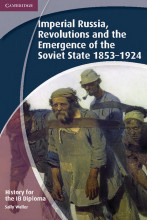Alexander II and the emancipation of the serfs 1855-81 - Emancipation of the Surfs - Methods
9 important questions on Alexander II and the emancipation of the serfs 1855-81 - Emancipation of the Surfs - Methods
Why did Alexander II increase censorship at the end of the 1850s?
What two conditions was the Emancipation Edict passed in 1861?
- Only applied to privately owned serfs
- Wasn't to be fully granted immediately, but would be passed in 3 stage process
When was a emancipation edict passed for state-owned serfs?
- Serfs could redeem more land
- Land prices were lower for Serfs
- Higher grades + faster learning
- Never study anything twice
- 100% sure, 100% understanding
How did Alexander II try to reassure the landowners before the Emancipation Edict?
"I hope gentlemen, that when you examined the projects put before you, you will be convinced that everything that it is possible to do to protect the interests of the landowners - has been done."
What was the first stage in the Emancipation Edict?
Serfs as free citizens could now:
- right to marry
- own property
- trade
- travel
- have legal protection
However, still had ton continue to fulfil labour service for another 2 years whilst land was evaluated
Stage Two of the Emancipation Edict: How was land allocated and what land was allocated to the Serfs?
- Cottage and surrounding plot
- Rest of land was allocated in small, scattered strips, to stop any one peasant getting any one type and quality
Land was allocated by:
- Regulatory charters drawn up the landowners which recorded the amount of land to to be given to the freed serfs and remaining obligations to the landowners; these were subject ot peasant approval under supervision of 'peace mediators'
- Although state gave maximum and minimum size allotments for regions; it varied widely and landowners actually allocated the land within this scope
Stage 3 of the Emancipation Edict: How did the freed-serfs pay for their land?
- 20% to the Landowner
- 80% paid back to the government over 49 years in instalments; known as 'redemption payments' with a 6% interest charge
- Volosts: Reconstituted village communes, or new township organisations of 2000-3000 people were responsible for collecting Peasant payments
- Redemption Payments varied according to the amount and quality of the land; however roughly they were equal to what the peasants had formerly paid as 'feudal dues'
What was the power of the "Mir" or "Obshchina" according to the Emancipation Edict?
- Several Mirs were united to forma volost; which was run by an assembly of delegates elected from the Mirs
- Tax collection: Taxes and redemption dues were collected by the Mirs annually an handed over to the Volost
- Authority: Mirs took over the administrative and judicial authority that the landowners had formerly held over the serfs
- Travel: Freed serfs had to remain in their mir until redemption payments were completed
- Crop Control: Mir controlled when fields were planted, when crops were harvested and plouging began, and redistributed land allotments if the village population changed
What did the Landowners lose and keep according the Emancipation Edict?
- Landowners received the price of land in long-term bonds issued by the government
- Some chose to sell additional land above their allocated share
- Landowners also retained ownership of meadows, pasture and woodland, as well as own land which was subsequently worked by hired labour
The question on the page originate from the summary of the following study material:
- A unique study and practice tool
- Never study anything twice again
- Get the grades you hope for
- 100% sure, 100% understanding
































